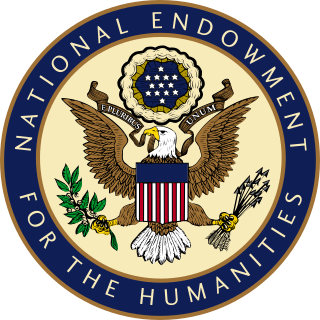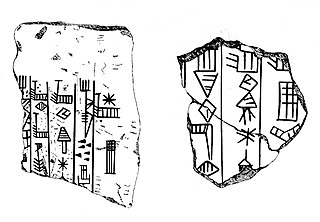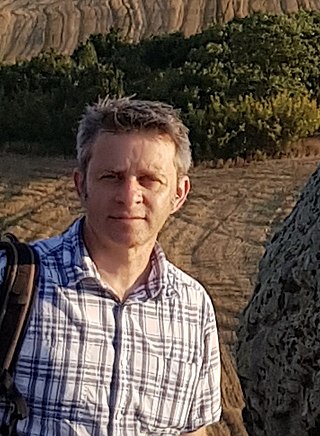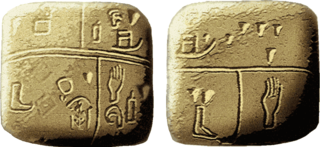Related Research Articles
The Perseus Digital Library, formerly known as the Perseus Project, is a free-access digital library founded by Gregory Crane in 1987 and hosted by the Department of Classical Studies of Tufts University. One of the pioneers of digital libraries, its self-proclaimed mission is to make the full record of humanity available to everyone. While originally focused on the ancient Greco-Roman world, it has since diversified and offers materials in Arabic, Germanic, English Renaissance literature, 19th century American documents and Italian poetry in Latin, and has sprouted several child projects and international cooperation. The current version, Perseus 4.0, is also known as the Perseus Hopper, and is mirrored by the University of Chicago.

Cuneiform is a logo-syllabic script that was used to write several languages of the Ancient Near East. The script was in active use from the early Bronze Age until the beginning of the Common Era. It is named for the characteristic wedge-shaped impressions which form its signs. Cuneiform was originally developed to write the Sumerian language of southern Mesopotamia. Cuneiform is the earliest known writing system.

The National Endowment for the Humanities (NEH) is an independent federal agency of the U.S. government, established by the National Foundation on the Arts and the Humanities Act of 1965, dedicated to supporting research, education, preservation, and public programs in the humanities. The NEH is housed at 400 7th St SW, Washington, D.C. From 1979 to 2014, NEH was at 1100 Pennsylvania Avenue, N.W., Washington, D.C., in the Nancy Hanks Center at the Old Post Office.
The National Digital Newspaper Program is a joint project between the National Endowment for the Humanities and the Library of Congress to create and maintain a publicly available, online digital archive of historically significant newspapers published in the United States between 1836 and 1922. Additionally, the program will make available bibliographic records and holdings information for some 140,000 newspaper titles from the 17th century to the present. Further, it will include scope notes and encyclopedia-style entries discussing the historical significance of specific newspapers. Added content will also include contextually relevant historical information. "One organization within each U.S. state or territory will receive an award to collaborate with relevant state partners in this effort." In March 2007 more than 226,000 pages of newspapers from California, Florida, Kentucky, New York, Utah, Virginia and the District of Columbia published between 1900 and 1910 were put online at a fully searchable site called "Chronicling America." As of December 2007, the total number of pages is about 413,000. This further expanded to be 1 million pages in 2009. Funding through the National Endowment for the Humanities is carried out through their "We The People" initiative.

The Proto-Elamite period, also known as Susa III, is a chronological era in the ancient history of the area of Elam, dating from c. 3100 BC to 2700 BC. In archaeological terms this corresponds to the late Banesh period. Proto-Elamite sites are recognized as the oldest civilization in the territory of present-day Iran.

Enshakushanna, or Enshagsagana, En-shag-kush-ana, Enukduanna, En-Shakansha-Ana, En-šakušuana was a king of Uruk around the mid-3rd millennium BC who is named on the Sumerian King List, which states his reign to have been 60 years. He conquered Hamazi, Akkad, Kish, and Nippur, claiming hegemony over all of Sumer.
The following outline is provided as an overview of and topical guide to anthropology:
Simon Martin is a British epigrapher, historian, writer and Mayanist scholar. He is best known for his contributions to the study and decipherment of the Maya script, the writing system used by the pre-Columbian Maya civilisation of Mesoamerica. As one of the leading epigraphers active in contemporary Mayanist research, Martin has specialised in the study of the political interactions and dynastic histories of Classic-era Maya polities. Since 2003 Martin has held positions at the University of Pennsylvania Museum of Archaeology and Anthropology where he is currently an Associate Curator and Keeper in the American Section, while teaching select courses as an Adjunct Associate Professor in the Department of Anthropology at the University of Pennsylvania.
Charles Brian Rose is an American archaeologist, classical scholar, and author. He is the James B. Pritchard Professor of Archaeology at the University of Pennsylvania in the Classical Studies Department and the Graduate Group in the Art and Archaeology of the Mediterranean World. He is also Peter C. Ferry Curator-in-Charge of the Mediterranean Section of the Penn Museum, and was the museum's Deputy Director from 2008-2011. He has served as the President of the Archaeological Institute of America, and currently serves as director for the Gordion excavations and as Head of the Post-Bronze Age excavations at Troy. Between 2003 and 2007 he directed the Granicus River Valley Survey Project, which focused on recording and mapping the Graeco-Persian tombs that dominate northwestern Turkey.
Åke W. Sjöberg was a leading Assyriologist, specialized in Sumerian language and literature.
Jürgen Renn is a German historian of science, and since 1994 Director at the Max Planck Institute for the History of Science in Berlin.

The complaint tablet to Ea-nāṣir is a clay tablet that was sent to ancient Ur, written c. 1750 BC. It is a complaint to a merchant named Ea-nāṣir from a customer named Nanni. Written in Akkadian cuneiform, it is considered to be the oldest known written complaint. It is currently kept in the British Museum. In 2015, the tablet's content and Ea-nāṣir in particular gained popularity as an internet meme.
The creation of the Max Planck Harvard Research Center for the Archaeoscience of the Ancient Mediterranean (MHAAM) was announced in February 2017 at Harvard University. It was inaugurated with a workshop and a signing ceremony at Harvard University on October 10, 2017, when the president of the Max Planck Society, Martin Stratmann, and Harvard's vice-provost for international affairs signed a five-year agreement.

David Wengrow is a British archaeologist and Professor of Comparative Archaeology at the Institute of Archaeology, University College London. He co-authored the international bestseller The Dawn of Everything: A New History of Humanity which was a finalist for the Orwell Prize in 2022. Wengrow has contributed essays on topics such as social inequality and climate change to The Guardian and The New York Times. In 2021 he was ranked No. 10 in ArtReview's Power 100 list of the most influential people in art.

Lugal-kinishe-dudu also Lugal-kiginne-dudu , was a King and (ensi) of Uruk and Ur who lived towards the end of the 25th century BCE. The Sumerian King List mentions Lugal-kinishe-dudu as the second king of the dynasty after En-shakansha-ana, attributing to him a fanciful reign of 120 years.

Enannatum II, son of Entemena, was Ensi (governor) of Lagash.
Robert K. Englund was an American Archaeologist and Assyriologist.
Grant Frame is a Canadian-American Assyriologist, Professor Emeritus of the University of Pennsylvania, and Curator Emeritus of the Babylonian Section of the University of Pennsylvania Museum of Archaeology and Anthropology. He is an expert on Akkadian language and literature and on the history and culture of ancient Mesopotamia in the first millennium BCE, in particular the Neo-Assyrian and Neo-Babylonian periods. Since 2008, he has served as Director and Editor-in-Chief of The Royal Inscriptions of the Neo-Assyrian Period (RINAP), an international research project funded by the U.S. government's National Endowment for the Humanities and other granting agencies, to translate the royal inscriptions of the rulers of Assyria from 744 to 609 BC. The RINAP project marks the continuation of the Royal Inscriptions of Mesopotamia (RIM) project, which Frame's teacher and mentor, Albert Kirk Grayson, founded at the University of Toronto in 1978 and led until his retirement with support from the Social Sciences and Humanities Research Council of Canada.

The Proto-Cuneiform script was used in Mesopotamia from roughly 3300 BC to 2900 BC. It arose from the token based system used in the region for the preceding millennia and was replaced by the development of early Cuneiform script in the Early Dynastic I period. While the underlying language of Cuneiform is definitively Sumerian, the language base for Proto-Cuneiform is as yet uncertain.
Lugalnamniršumma was an ancient Iraqi ruler. He ruled sometime during the Early Dynastic IIIb period ; additionally, temp. Akalamdug, Urnanshe, Akurgal, Paraganedu, and Ennail. Ursangpae may have preceded Lugalnamniršumma as a king of Uruk. Lugalnamniršumma may have also been succeeded by Lugalsilâsi I as a great king of Kish.
References
- 1 2 3 4 "About CDLI". Cuneiform Digital Library Initiative. Retrieved 2014-06-12.
- ↑ "Associates & Staff". Cuneiform Digital Library Initiative. Retrieved 2009-06-12.
- ↑ "Cuneiform Goes Digital: UCLA Scholar Sheds Light on Cultural History of Ancient Iraq". National Humanities Center. 2004-04-28. Retrieved 2009-02-21.
- ↑ "Web library assembling ancient written documents". USA Today. Associated Press. 2002-05-17. Retrieved 2009-02-21.